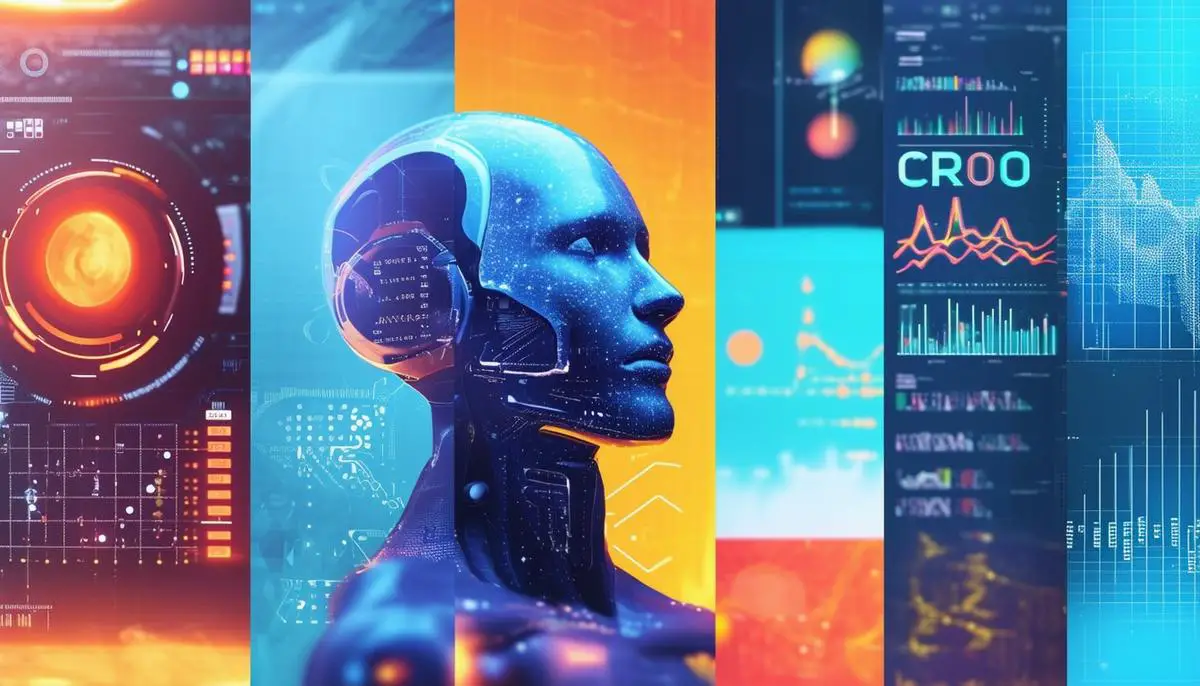Conversion rate optimization (CRO) is a vital strategy in digital marketing that focuses on increasing the percentage of website visitors who take desired actions, such as making a purchase or filling out a form. By enhancing user experience and leveraging advanced technologies like machine learning, businesses can improve their online performance and revenue.
Introduction to Conversion Rate Optimization
Conversion rate optimization (CRO) is a technique in digital marketing aimed at turning more website visitors into paying customers or leads. It focuses on refining the user experience to boost the percentage of visitors who complete a desired action, like making a purchase or filling out a form.
CRO is important for businesses because it can directly affect revenue. Instead of investing more in driving traffic, CRO focuses on maximizing the value of existing visitors. Improved conversion rates mean more value from every visitor, turning efforts into measurable gains without necessarily increasing marketing spend.
A key part of CRO is improving the user experience (UX). When users find it easy to use a site and engage with content, they are more likely to take action. This can involve simple changes like improving site navigation or technical adjustments like reducing load times.
CRO also helps in retaining existing customers. By continually optimizing websites based on user behavior and feedback, businesses can keep improving the experience for returning visitors. Consistent positive interactions can increase customer loyalty and lifetime value.
Some key elements of CRO include:
- A/B Testing: Comparing two versions of a webpage to see which performs better.
- Heatmaps: Visual tools that show where users click, move, and scroll on a website.
- User Feedback: Surveys and feedback forms to understand user preferences and pain points.
Here's a simple table showcasing the potential impact of CRO on an e-commerce site:
| Metric | Before CRO | After CRO |
|---|---|---|
| Monthly Visitors | 10,000 | 10,000 |
| Conversion Rate (%) | 2% | 4% |
| Conversion Actions (Sales) | 200 | 400 |
| Revenue ($) | 4,000 | 8,000 |
Integrating machine learning into CRO can further refine the process by analyzing data to identify trends and patterns that predict user behavior more accurately.1
Role of Machine Learning in CRO
Machine learning enhances CRO by analyzing extensive datasets to uncover trends, patterns, and anomalies that might be overlooked through traditional methods. This analytical power allows businesses to better understand user behavior and make data-driven decisions to optimize their websites.
Key advantages of machine learning in CRO include:
- Real-time data analysis: Ensures optimization strategies are continually refined based on current user behavior.
- Predictive analytics: Forecasts future actions, allowing businesses to anticipate user needs and create personalized experiences.
- Enhanced A/B testing: Analyzes numerous variables simultaneously, providing deeper insights and more robust optimization strategies.
- Dynamic content adjustments: Modifies website elements in real-time based on user interactions, ensuring relevant and engaging content.
- Automation of routine tasks: Frees up marketing teams to focus on more strategic aspects of their campaigns.
By leveraging machine learning, businesses can create more effective and efficient optimization strategies, leading to improved user experiences and higher conversion rates.2

AI-Powered Tools for CRO
AI-powered tools are instrumental in modern CRO strategies, offering precise data analysis, real-time adjustments, and personalized user experiences. Three impactful AI-powered tools in CRO include:
- Predictive analytics: Uses AI algorithms to analyze historical and real-time data, identifying patterns that can forecast future user behavior. This allows businesses to adapt their strategies to meet user expectations.
- Chatbots: Virtual assistants that provide instant, around-the-clock customer support. They can handle various tasks, from answering questions to guiding users through the purchasing process, reducing bounce rates and increasing conversion likelihood.
- Personalized product recommendations: Analyzes user behavior, purchase history, and preferences to suggest products that are most likely to appeal to individual users. This enhances the shopping experience and increases the chances of a purchase.
Other AI-driven tools for CRO include:
- Content optimization tools: Automatically adjust website content based on user interactions.
- Dynamic pricing: Optimizes product prices in real-time to maximize sales and profits.
By integrating these tools, businesses can achieve higher conversion rates, improved customer satisfaction, and increased revenue.3

Implementing AI in CRO Strategies
Integrating AI into CRO strategies involves several key steps:
- Select appropriate AI tools based on business needs and objectives.
- Set up and connect tools to existing data sources, such as website analytics and CRM systems.
- Analyze data using AI to identify trends and opportunities for optimization.
- Make data-driven decisions based on AI-generated insights.
- Implement A/B testing with AI to refine strategies continually.
- Use dynamic content adjustment to adapt the user experience in real-time.
- Maintain a feedback loop by monitoring performance, gathering user feedback, and updating AI systems.
By following these steps, businesses can leverage AI technology to enhance their CRO efforts, leading to improved user experiences and higher conversions.4
"The future of CRO lies in the intelligent application of AI and machine learning to create personalized, dynamic user experiences that adapt in real-time to individual preferences and behaviors."

Case Studies of AI-Driven CRO
Various businesses have successfully leveraged AI in their CRO strategies, yielding impressive results. Here are some real-life case studies that detail the AI technologies used, the outcomes, and the lessons learned.
Case Study 1: E-commerce Giant Boosts Conversion with AI-Powered Product Recommendations
An e-commerce company integrated an AI-powered recommendation engine that analyzed customer behavior, purchase history, and browsing patterns to provide customized product suggestions.
Technologies Used:- Machine Learning Algorithms
- Predictive Analytics
Within six months, the personalized recommendations led to a 25% increase in conversion rates and a 15% growth in average order value.
Lessons Learned:- Personalization enhances user engagement and conversion.
- AI can process massive datasets to provide accurate, relevant recommendations.
Case Study 2: Financial Services Firm Enhances User Experience Through AI-Driven Insights
A financial services firm employed AI to analyze user behavior on their application pages, identifying where users dropped off and why.
Technologies Used:- Natural Language Processing (NLP)
- Heatmaps and Session Recording
The firm saw a 40% reduction in abandonment rates and a 30% increase in completed applications within three months.
Lessons Learned:- AI tools like heatmaps and session recordings provide valuable insights into user interactions.
- Simplifying complex processes based on AI-driven data can improve conversion rates.
Case Study 3: SaaS Company Improves Lead Generation with AI Chatbots
A SaaS company integrated AI chatbots to provide instant, 24/7 customer support on their website.
Technologies Used:- AI Chatbots
- Natural Language Processing (NLP)
The implementation led to a 35% increase in lead generation and a 20% improvement in customer satisfaction scores.
Lessons Learned:- Instant support through AI chatbots can reduce drop-off rates and enhance user satisfaction.
- Automating repetitive tasks allows human agents to focus on more complex issues.
Case Study 4: Retail Brand Achieves Higher Conversions with AI-Driven Dynamic Pricing
A retail brand utilized AI-driven dynamic pricing to stay competitive and meet customer expectations.
Technologies Used:- Real-Time Data Analysis
- Predictive Analytics
Dynamic pricing strategies resulted in a 20% increase in sales and a 10% boost in profit margins over six months.
Lessons Learned:- Real-time data analysis and dynamic adjustments can impact sales and profitability.
- AI's ability to adapt to market changes offers a competitive edge in pricing strategies.
Case Study 5: Hospitality Chain Optimizes Booking Process with AI
A hospitality chain integrated AI tools to optimize their online booking process by analyzing user interactions and recommending suitable accommodations and packages.
Technologies Used:- Machine Learning
- Predictive Analytics
The chain saw a 25% increase in completed bookings and a 15% increase in revenue per booking.
Lessons Learned:- Anticipating user needs and providing customized recommendations can enhance user satisfaction and conversion rates.
- Streamlined processes, guided by AI insights, lead to higher completion rates and increased revenue.
These case studies demonstrate the potential of AI in CRO across various sectors, showing improvements in conversion rates, user satisfaction, and overall revenue.

Challenges and Limitations of AI in CRO
While AI-driven CRO presents opportunities for enhancing conversion rates, it also comes with challenges and limitations that businesses must address.
Data quality is crucial for effective AI in CRO. AI algorithms rely on high-quality data to accurately analyze user behavior and predict future actions. Incomplete or inaccurate data can lead to erroneous insights and suboptimal optimization strategies.
Technical expertise is required to effectively implement and manage AI tools. Many businesses may lack the in-house knowledge needed to handle these complex technologies, making it necessary to invest in training or collaborate with external specialists.
Ethical considerations play a role when utilizing AI for CRO. The use of AI-driven personalization and data analysis raises concerns about user privacy and data security. Businesses must ensure transparency about their data collection practices and comply with relevant privacy regulations.
AI can potentially produce biased outcomes, inadvertently perpetuating existing biases in data. This can lead to unfair and discriminatory practices. Businesses need to implement measures to identify and mitigate biases within their AI models.
There's a risk of AI over-optimizing for short-term gains at the expense of long-term goals. AI algorithms can become focused on immediate conversion metrics, potentially overlooking broader business objectives such as brand loyalty and customer satisfaction.
The evolving nature of AI technology requires businesses to stay updated with the latest developments and adapt their CRO strategies accordingly. This ongoing adaptation requires a commitment to continuous learning and flexibility.
"By addressing these challenges, businesses can effectively harness the power of AI in their CRO efforts, leading to enhanced conversion rates, improved user experiences, and sustained revenue growth."

CRO is a valuable tool for businesses aiming to enhance user experiences, retain customers, and maximize revenue. By optimizing based on data-driven insights and integrating technologies like AI, companies can achieve improvements in their conversion rates and online success. Recent studies have shown that businesses implementing AI-driven CRO strategies can see up to a 30% increase in conversion rates1.


